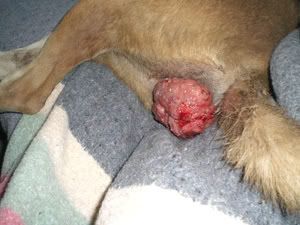Canine transmissible venereal tumors are cauliflower-like, pedunculated, and nodular, papillary, or multilobulated in appearance. They range in size from a small nodule (5 mm) to a large mass (>10 cm) that is firm, though friable. The surface is often ulcerated and inflamed and bleeds easily. TVT may be solitary or multiple and are almost always located on the genitalia. They may be transplanted to adjacent skin and oral, nasal, or conjunctival mucosae. The tumor may arise deep within the prepuce or vagina and be difficult to see during cursory examination. This may lead to misdiagnosis if genital bleeding is incorrectly assumed to be hematuria. The tumor is transplanted from site to site and dog to dog by direct contact with the mass. Initially, TVT grow rapidly. Metastasis is uncommon (5%). When metastasis occurs, it is usually to the regional lymph nodes, but kidney, spleen, eye, brain, pituitary, skin and subcutis, mesenteric lymph nodes, and peritoneum may also be sites.
 Because of their homogenous populations of large, round cells with distinctive centrally located nucleoli, TVT are usually easily diagnosed by cytologic examination of fine-needle aspirates or impression smears or by histopathologic evaluation of biopsies. TVT may be difficult to distinguish from other round cell tumors, particularly lymphosarcomas, when they occur in extragenital locations. Prevalence varies from relatively high in some geographic regions to rare in others.
Because of their homogenous populations of large, round cells with distinctive centrally located nucleoli, TVT are usually easily diagnosed by cytologic examination of fine-needle aspirates or impression smears or by histopathologic evaluation of biopsies. TVT may be difficult to distinguish from other round cell tumors, particularly lymphosarcomas, when they occur in extragenital locations. Prevalence varies from relatively high in some geographic regions to rare in others.
Although spontaneous regression can occur, TVT are usually progressive and are treated accordingly. Complete surgical excision, radiation therapy, and chemotherapy are effective treatments; however, chemotherapy is considered the treatment of choice. Vincristine sulfate is reported to be effective, except when the tumor is in the CNS or eye. Usually, total remission can be expected by the sixth treatment. Adriamycin also has been effective for those animals that do not respond to vincristine. The prognosis for total remission with chemotherapy or radiation therapy is good, unless there is metastatic involvement of organs other than skin. Complete surgical excision often cannot be achieved because of the anatomic location of many of these tumors. Recurrence is likely in such cases unless adjunct radiation or chemotherapy is used.


No comments:
Post a Comment